
Milan
Siamo Foresta
From to
Encounters
Gli artisti / The artists: Cai Guo-Qiang, Sheroanawe Hakihiiwe, Fabrice Hyber, Joseca Mokahesi, Adriana Varejão, Ehuana Yaira.
Il percorso in mostra si dipana lungo diversi nuclei espositivi e tre incontri tra artisti autoctoni e non, che hanno generato dialoghi e opere inedite: l’artista Yanomami venezuelano Sheroanawe Hakihiiwe e l’artista francese Fabrice Hyber, che hanno lavorato insieme nella primavera del 2023; l'artista di Rio de Janeiro Adriana Varejão e Joseca Mokahesi, yanomami del Brasile, nel 2003; e la recentissima collaborazione tra Ehuana Yaira, yanomami brasiliana e l'artista cinese Cai Guo-Qiang. Questi tre momenti hanno permesso uno scambio generoso tra mondi solitamente lontani.
The exhibition’s parcours unfolds along various focal points and three encounters between Indigenous and non-Indigenous artists, which have generated unique dialogues and new artworks: Yanomami Venezuelan artist Sheroanawe Hakihiiwe and French artist Fabrice Hyber, who worked together in April 2023; Brazilian artist Adriana Varejão with Brazilian Yanomami artist Joseca Mokahesi, back in 2003; and the recent collaboration of Yanomami artist Ehuana Yaira and Chinese artist Cai Guo-Qiang. These three moments have allowed a generous exchange between usually distant worlds.
DI FORESTA IN FORESTA: Sheroanawe Hakiihiwe nella Vallée di Fabrice Hyber
Nel cuore della regione della Vandea, in Francia, l'artista francese Fabrice Hyber ha piantato una foresta sin dagli anni Novanta, intorno alla fattoria dei suoi genitori, allevatori di pecore. Nella valle di Serrie, è nata quindi una grande foresta da circa 300.000 semi di alberi di centinaia di specie diverse, seminati nel corso del tempo.
Luogo di apprendimento e di sperimentazione, la Vallée è diventata la matrice e la fonte di ispirazione della sua intera produzione artistica, che Hyber paragona alla crescita organica della vita: "Fondamentalmente, faccio la stessa cosa con le opere: semino alberi come semino segni e immagini. Sono lì, pianto semi di pensiero che sono visibili, si fanno strada e crescono. Non ho più controllo su di essi”.
L'idea di invitare in Vandea l'artista yanomami Sheroanawe Hakihiiwe, venezuelano, è nata dall'incontro con Fabrice Hyber nel 2022, durante la mostra Les Vivants organizzata dalla Fondation Cartier pour l'art contemporain al Tripostal di Lille (Francia). La foresta si è rivelata un comune denominatore tra due artisti dalle origini apparentemente lontane, un luogo di riflessione sulla fertilità della vita e sulle sue metamorfosi. Nell'aprile 2023, la foresta di Fabrice Hyber diventa un luogo di creazione e incontro per questi due artisti.
Dopo diversi scambi di informazioni e visioni sui loro habitat rispettivi, gli artisti hanno preso la decisione di creare insieme diverse opere, letteralmente realizzate a quattro mani, in una totalizzante fusione di intenti che rende i due artisti co-autori.
FROM FOREST TO FOREST: Sheroanawe Hakihiiwe in the Vallée of Fabrice Hyber
In the heart of the Vendée region in France, French artist Fabrice Hyber has been sowing a forest around his parents’ former sheep farm since the 1990s. Sown over a period of time, several hectares of forest have grown in the Serrie valley from around 300,000 tree seeds of several hundred species.
A place of learning and experimentation, the Vallée has become the matrix and source of inspiration for the artist's entire body of work, which he compares to the organic growth of life: “I basically do the same thing with my works, I sow trees as I sow signs and images. They are there, I sow seeds of thought that are visible, they gain ground and they grow. I am no longer in control”.
The idea of inviting Yanomami artist Sheroanawe Hakihiiwe, from Venezuela, arose from his meeting with Fabrice Hyber in 2022 during the exhibition Les Vivants organised by the Fondation Cartier pour l'art contemporain at the Tripostal in Lille (France). The forest proved to be a common denominator for both artists who are from apparently distant origins, as a place of reflection on the richness of life and its metamorphoses. In April 2023, the forest became a place of creation for the two of them.
After exchanging their personal visions on their respective habitats, the artists took the decision to create several works together, in a total fusion of intentions, for which they are co-authors.
Image gallery

© Fabrice Hyber Sheroanawe Hakihiiwe
© Charles-Henri Paysan / Lumento
.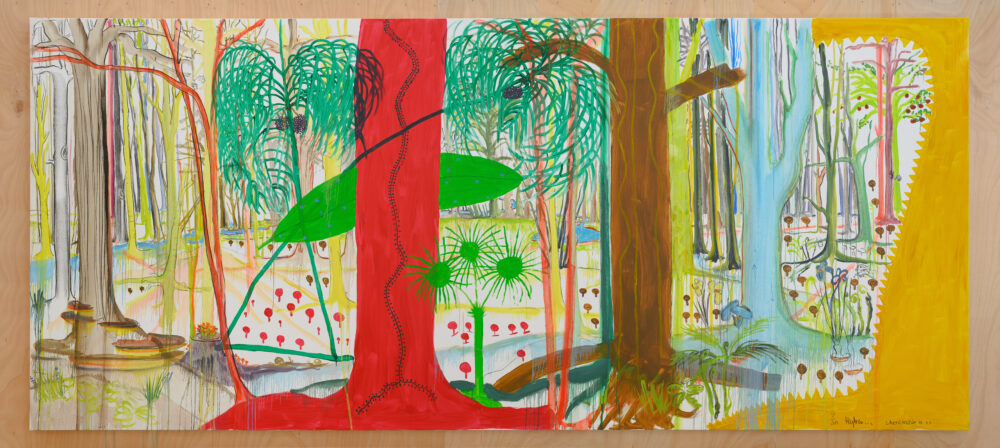
© Fabrice Hyber Sheroanawe Hakihiiwe
. Picture© Charles-Henri Paysan / Lumento
.
© Fabrice Hyber Sheroanawe Hakihiiwe
© Charles-Henri Paysan / Lumento
.Fabrice Hyber
Fabrice Hyber propone, attraverso i suoi dipinti, un'osservazione poetica e personale del mondo vegetale. ll vocabolario plastico dell'artista si collega alle più attuali ricerche scientifiche sull'intelligenza delle piante o sulla comunicazione degli alberi, interrogandosi sui principi della crescita dei rizomi, dell’energia e della mutazione, della mobilità e della metamorfosi. Sostenitore di un'ecologia positiva, Hyber è affascinato dalle infinite possibilità di rigenerazione del mondo vivente. "Il dipinto Invasion presenta una sorta di esercito di uomini verdi, personaggi che danno la vita in modo permanente, guardiani dei vivi". A proposito di Greffe [lett. “trapianto”]: "È un quadro legato al mio interesse per i trapianti di organi. Ho pensato che potremmo immaginare di innestare delle piante nel nostro corpo. La gamba qui è come un albero. Interroga il futuro, una possibile mutazione”.
In his paintings, Fabrice Hyber offers a poetic and personal observation of the vegetal world. The artist joins, through his creative vocabulary, the most current scientific research on plant intelligence and the ways trees communicate, exploring the principles of growth of the rhizome, energy and transformation, mobility and metamorphosis. A positive ecology enthusiast, Hyber looks with curiosity at the infinite regenerative possibilities of the living world. "The canvas Invasion presents an army of green men, characters who are continuously giving life, guardians of the living". On Greffe (lit. “Transplant”): "It's a picture linked to my interest in organ transplants; I thought we could imagine transplanting plants in our bodies. The leg here is a tree. It is questioning the future, a possible mutation”.
Image gallery

© Fabrice Hyber
. Picture© ADAGP
.
Biography
Nato nel 1961 a Luçon, Vandea, Francia. Vive a Parigi e a Mareuil-sur-Lay-Dissais (Vandea), Francia.
Fabrice Hyber, artista, ricercatore, imprenditore e poeta, vive e lavora tra Parigi e la regione della Vandea dove, da oltre 40 anni, ha piantato circa 300.000 alberi, trasformando gradualmente i campi in foreste e il paesaggio in un’opera d’arte. Ha studiato matematica prima di entrare all’École des Beaux-Arts di Nantes. Artista-imprenditore, nel 1994 ha creato Unlimited Responsibility (UR), una società ideata per promuovere la produzione e lo scambio di progetti tra artisti e imprenditori. Nel 1997 ha ricevuto il Leone d’oro per il progetto dello studio televisivo realizzato per il padiglione francese alla Biennale di Venezia. La trasmissione è al centro del lavoro di questo artista che, dal 2012, ha lanciato un nuovo concetto di scuola d’arte, tra scuola d’impresa e scienza dell’arte. Nel 2021, Fabrice Hyber è stato eletto all’Académie des Beaux-Arts nel 2018 e nominato ambasciatore dell’ONF (Office National des Forêts). L’artista ha mantenuto stretti legami con la Fondation Cartier pour l’art contemporain fin dai tempi della sua residenza presso L’instituzione, nel 1990. Da dicembre 2022 ad aprile 2023, la Fondation Cartier ha dedicato a Fabrice Hyber una grande mostra personale dal titolo La Vallée.
Born in 1961, Luçon, Vendée, France. Lives in Paris and Mareuil-sur-Lay-Dissais (Vendée), France.
Artist-sower, researcher, entrepreneur, and poet, Fabrice Hyber lives and works between Paris and the Vendée region where, for more than 40 years, he has been sowing around 300,000 trees, gradually transforming fields into a forest, and the landscape into a work of art. He studied mathematics before entering the École des beaux-arts in Nantes. An artist-entrepreneur, he created Unlimited Responsibility (UR) in 1994, a limited liability company designed to promote the production and exchange of projects between artists and entrepreneurs. In 1997, he received the Golden Lion for the television studio project realised for the French pavilion at the Venice Biennale. Transmission is at the heart of this artist’s work: since 2012, he has launched a new concept of art school, between a business school and the sciences of art. Fabrice Hyber was elected to the Academy of Fine Arts in 2018, and appointed ambassador of the ONF (the National Office for Forests) in 2021. The artist has maintained close ties with the institution since 1990. From December 2022 to April 2023, the Fondation Cartier devoted a major solo exhibition to Fabrice Hyber, titled La Vallée.
Sheroanawe Hakihiiwe
Solo in apparenza non figurativa, l'opera di Sheroanawe Hakihiiwe, Yanomami del Venezuela, si ispira intrinsecamente ai dettagli della foresta in cui vive: le tracce, le forme e i "segni speciali" degli animali e delle piante amazzoniche. Il suo processo di astrazione è molto simile a quello delle pitture che gli yanomami realizzano sul loro corpo, a loro volta ispirate dai tratti distintivi degli antenati mitologici umani e animali. Negli anni 2000, l’artista ha inventariato sistematicamente i motivi di questa tradizione grafica e simbolica.
La serie Sequía (Siccità), realizzata nel 2021 su tre diversi tipi di carta, è un lavoro di sensibilizzazione: "I fiumi e i torrenti si stanno prosciugando, c'è meno acqua per irrigare le colture, meno pesce. Anche gli animali cercano l'acqua e migrano, quindi ci sono meno animali da cacciare. Gli sciamani dicono che il clima è molto cambiato e sono preoccupati. Ci sono anche incendi che non portano nulla di buono per noi”.
Sheroanawe Hakihiiwe ha realizzato la pittura murale intitolate Wamono (percorso delle formiche tagliafoglie) che attraversa la mostra. Il motivo impiegato raffigura le numerose grandi formiche rosse (Atta sexdens) che stanno devastando le piantagioni di manioca tagliando le foglie delle colture.
Non-figurative in appearance, the work by Sheroanawe Hakihiiwe, a Yanomami artist from Venezuela, is meticulously inspired by details from the forest in which he lives: traces, forms and "special signs" of Amazonian animals and vegetation. His process of abstraction is very similar to that of Yanomami body paintings, which originate from distinctive features of mythological ancestors, both human and animal. During the 2000s, he also produced a systematic inventory of the motifs of this traditional symbology.
The series Sequía (Drought), created in 2021, on three different types of paper, raises consciousness: "Rivers and streams are drying up, there is less water to irrigate crops, fewer fish, animals also seek water and move away, so there are fewer animals to hunt. Shamans say that the climate is very different, and they are worried. There are also fires that are not good for us.”
Sheroanawe Hakihiiwe has realised the wall paintings titled Wamono (path of leafcutter ants) that run through the exhibition: this pattern depicts the numerous large red ants (Atta sexdens) which are devastating cassava plantations by cutting the crops’ leaves.
Image gallery

© Sheroanawe Hakihiiwe
.
© Sheroanawe Hakihiiwe
.
© Sheroanawe Hakihiiwe
.
© Sheroanawe Hakihiiwe
.
Biography
Nato nel 1971 a Sheroana, Amazonas, Venezuela. Vive nella comunità di Poripori (Mahekoto) sull'alto fiume Orinoco, in Amazzonia, Venezuela.
Sheroanawe Hakihiiwe è un artista yanomami della regione dell’Alto Orinoco. Ha frequentato la scuola interculturale della Missione Salesiana locale. A metà degli anni Novanta ha incontrato l’artista messicana Laura Anderson Barbata, che gli ha insegnato l’arte di creare la carta. Vive nella sua comunità Pori Pori quasi tutto l’anno, e annota su dei quaderni le sue osservazioni quotidiane nella foresta sotto forma di disegni. Da questi schizzi e annotazioni, in un laboratorio di Caracas dipinge e stampa le sue opere su carta fatta a mano con fibre di alberi o piante della sua terra natale. L’artista ha preso a cuore il processo di fabbricazione della carta, che è alla base della sua vocazione artistica e della sua ricerca estetica fin dagli anni Novanta.
Dalla sua prima mostra a Caracas nel 2010, le opere di Sheroanawe Hakihiiwe sono state esposte negli Stati Uniti, in America Latina e in Europa. Nel 2022 partecipa alla Biennale di Venezia, alla Biennale di Sydney e alla mostra organizzata dalla Fondation Cartier Les Vivants a Lille. Nel 2023 ha preso parte alla mostra La lotta yanomami, organizzata dalla Fondation Cartier allo Shed di New York.
Born in 1971, Sheroana, Amazonas, Venezuela. Lives in the Poripori community (Mahekoto) on the upper Orinoco river in the Amazon, Venezuela.
Sheroanawe Hakihiiwe is a Yanomami artist from the upper Orinoco area. He attended the intercultural school of the local Salesian Mission. In the mid-1990s, he met Mexican artist Laura Anderson Barbata who taught him the art of hand-making paper. He lives within his community Pori Pori most of the year, during which he records in notebooks the draft drawings inspired by his daily observations in the forest. From these sketches and annotations, he then paints or prints his works in a studio in Caracas on handmade paper specially manufactured with fibres from trees or plants from his native land. He takes the greatest care in this artisanal papermaking process which has given rise to his artistic vocation and aesthetic quest since the1990s.
Since his first exhibition in Caracas in 2010, Sheroanawe Hakihiiwe has been exhibited in the United States, Latin America, as well as in Europe at the Venice Biennale (2022) and at the Biennale of Sydney (2022). It is also in 2022 that he participated in the exhibition organised by the Fondation Cartier Les Vivants in Lille, and in 2023 in the exhibition The Yanomami Struggle at the Shed in New York.
ISPIRAZIONI SCIAMANICHE: Dialogo tra Adriana Varejão e l'opera di Joseca Mokahesi
È nel 2003, durante la preparazione della mostra Yanomami. L’esprit de la forêt, che l'artista brasiliana Adriana Varejão, su invito della Fondation Cartier e in compagnia di altri artisti internazionali, si reca nelle comunità dell'Amazzonia brasiliana, con l’intento di dialogare con le immagini e le voci degli abitanti della foresta pluviale e con gli sciamani della casa-villaggio Watorikɨ, nello stato brasiliano Amazonas.
Affascinata, durante la sua permanenza presso gli Yanomami, dalle piante con poteri psicotropi da cui viene ricavata la polvere inalata durante i rituali sciamanici, ne farà il soggetto di dipinti su larga scala, a mo’ di antiche tavole botaniche di tradizione occidentale.
"Cerco di riprodurre queste specie come se si trattasse di un disegno scientifico, suggerendo anche quanto il linguaggio scientifico sia lontano dalla conoscenza degli sciamani. È come se la scienza fosse in grado di 'naturalizzare' queste specie vegetali, abolendo così la loro soggettività”.
Il disegno dell'artista yanomami brasiliano Joseca Mokahesi a cui Varejão si è ispirata rappresenta il corpo frammentato dell'apprendista sciamano, trasformato dai suoi futuri spiriti ausiliari durante il rituale di iniziazione, che ispirerà anche Adriana Varejão per il suo dipinto Cadernos de viagem, connaissance par corps. L'immagine sciamanica del corpo smembrato e ricostruito al contrario viene ripresa e reimmaginata questa volta su un supporto molto più grande dell'originale di Joseca Mokahesi, una pittura in olio di lino che richiama il riferimento occidentale all'Ecce homo di Leonardo da Vinci. Anche in questo caso, l'apparenza scientifica è minata dal soggetto: il corpo visibile è raddoppiato da un corpo simbolico letteralmente invertito.
SHAMANIC INSPIRATIONS: A dialogue between Adriana Varejão and the work of Joseca Mokahesi
In 2003, in preparation for the exhibition Yanomami. L’esprit de la forêt Brazilian artist Adriana Varejão travelled to the Brazilian Amazon Forest to visit the Yanomami people, at the invitation of the Fondation Cartier together with other international artists. Here she began a dialogue with the shamans of the village house of Watorikɨ, in Amazonas, about the images and voices of the rainforest people.
During her stay with the Yanomami, Adriana Varejão was fascinated by the plants with psychotropic powers from which the powder inhaled during shamanic rituals is made. In turn, she made it the subject of large-scale paintings, in the style of old Western botanical plates.
"I endeavour to reproduce these species in the manner of a scientific drawing, all the while alluding to the divide between scientific languages and shamanic knowledge. We proceed as if science was capable of ‘naturalising’ these species, thereby doing away with its subjectivity.”
It is a drawing by Brazilian Yanomami artist Joseca Mokahesi, representing the fragmented and altered body of the apprentice shaman by his future auxiliary spirits during his initiation ritual, that has also inspired Adriana Varejão for her painting Cadernos de Viagem, connaissance par corps. The shamanic image of the dismembered body, reconstructed in reverse, is revisited and reimagined this time with oil on linen canvas, on a much larger format than Joseca Mokahesi's original, which summons the Western reference of Leonardo da Vinci's Ecce homo. Here again, the scientific appearance is undermined by the subject: the visible body is doubled by a symbolic body, literally reversed.
Image gallery
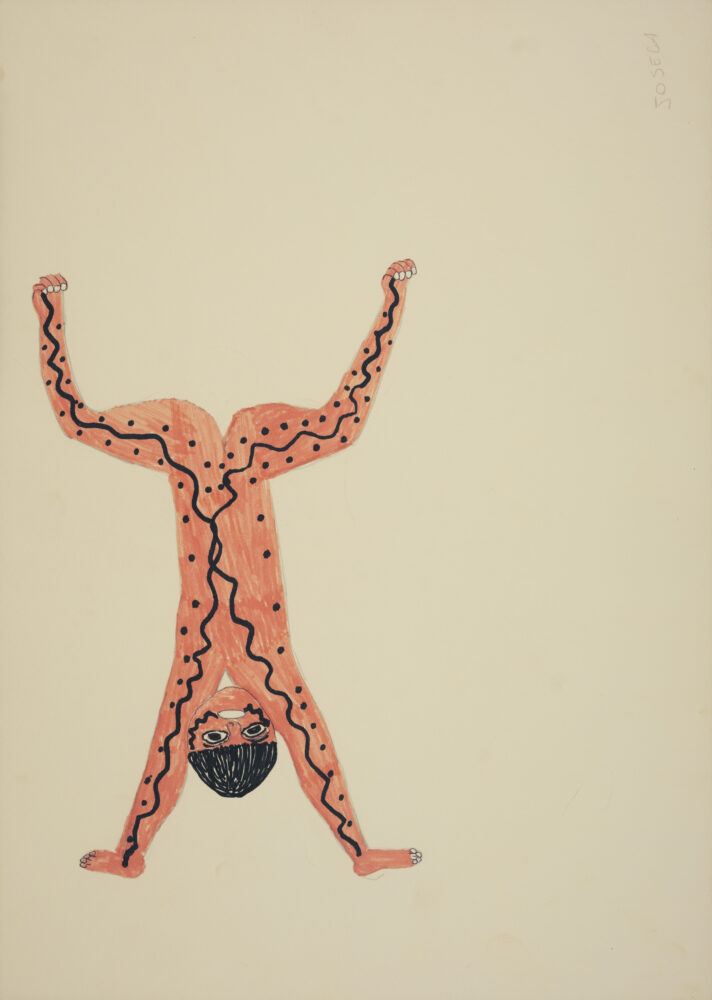
© Joseca Mokahesi/ Bruce Albert
.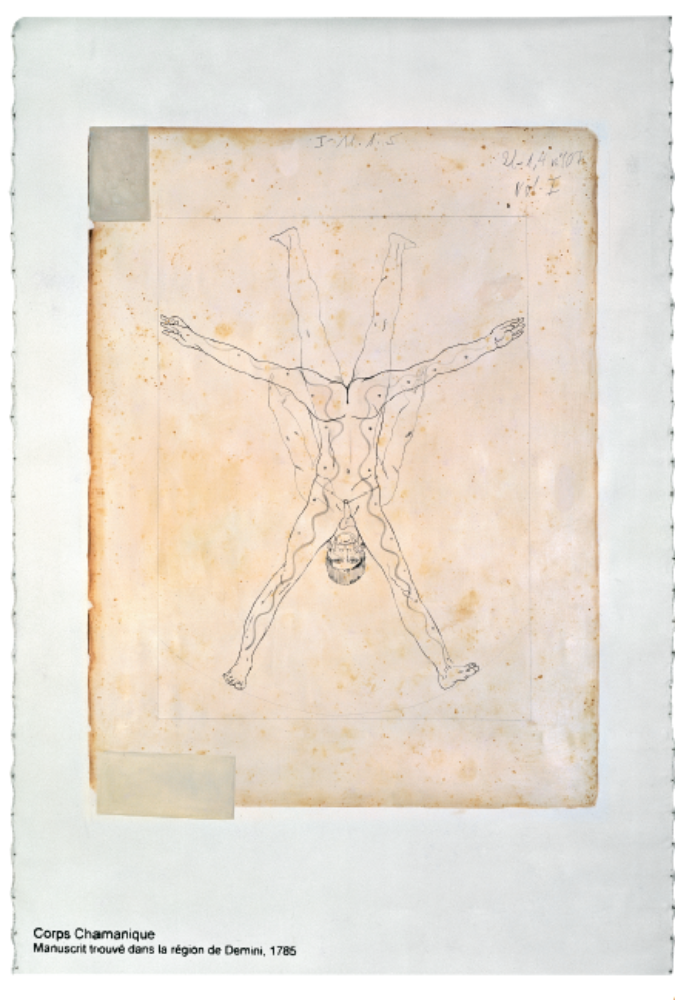

Picture
Adriana Varejão Archives
.
Adriana Varejão
L’approccio di Adriana Varejão, artista di Rio de Janeiro, integra e rimette in discussione i limiti della pittura, della scultura e dell'architettura servendosi di molteplici riferimenti artistici e culturali del passato. L’artista attribuisce particolare importanza alla storia sanguinosa del suo paese. Le questioni di schiavitù, della colonizzazione e della sua barbarie, sono sempre in primo piano nel suo lavoro. Le sue opere diventano lo strumento di un discorso, che testimonia e denuncia. Nel 2003, per iniziativa della Fondation Cartier, visita il villaggio di Watoriki nel nord del Brasile ed entra così in contatto con gli artisti della comunità, assistendo ai rituali sciamanici. Nelle sue opere cominciano ad apparire corpi sciamanici e piante psicotrope disegnate come negli antichi erbari. "Cerco di riprodurre queste specie alla maniera di un disegno scientifico e anche di suggerire quanto i linguaggi scientifici siano lontani dalla conoscenza degli sciamani".
The artistic approach of Adriana Varejão, from Rio de Janeiro, integrates and pushes the limits of painting, sculpture and architecture using multiple artistic and cultural references from the past. Adriana Varejão places particular importance to the bloody history of her country; slavery, colonisation and their barbarism are prominent themes in her work. Becoming the vehicle of a discourse, her work testifies and denounces. In 2003, by initiative of Fondation Cartier, she visited the village of Watorikɨ in north Brazil, made contact with the artists of the community, and attended shamanic rituals. In her work appears the shamanic body and the psychotropic plants, presented like ancient herbaria. “I endeavor to reproduce these species in the manner of a scientific drawing, all the while alluding to the divide between scientific languages and shamanic knowledge”.
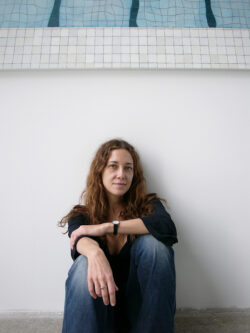
Biography
Nata nel 1964 a Rio de Janeiro, Brasile. Vive a Rio de Janeiro, Brasile.
Le opere di Adriana Varejão traggono ispirazione da molti riferimenti culturali. Il suo approccio artistico si spinge al limite della pittura della scultura e dell’architettura. Adriana Varejão attribuisce particolare importanza alla storia (sanguinosa) del suo paese: alla questione della schiavitù in primo luogo, ma anche della colonizzazione e della sua barbarie, sempre in primo piano nel suo lavoro. Le sue opere diventano lo strumento di un discorso di testimonianza e denuncia. Immagini e forme di diversa origine tratte dall’arte occidentale del XVI e XVII secolo, dalla tradizione degli azulejos portoghesi o dalla ceramica cinese - sono incorporate nella sua opera per far rivivere la loro storia e utilizzarla per costruire nuove versioni della stessa. In alcune opere emblematiche, come Parede com incisões à la Fontana (Muro con incisioni alla maniera di Fontana, 2002) le piastrelle sono incise, mostrando così le viscere della tela. Come molti critici hanno sottolineato, la pittura di Adriana Varejão si fa “corpo” e il suo lavoro diventa una forma di “barocco contemporaneo”.
Le opere di Adriana Varejão sono state oggetto di importanti mostre personali e sono state presentate alle biennali di Venezia, San Paolo e Sydney.
Varejão ha preso parte nel 2003 alla mostra Yanomami. Esprits de la forêt, alla Fondation Cartier, dove le è stata anche dedicata una mostra personale nel 2005, Chambre d’échos. Le sue opere sono state esposte in diverse occasioni dalla Fondation Cartier : Les Habitants nel 2014 e Le Grand Orchestre des Animaux nel 2016 a Parigi, Les Visitants nel 2017 a Buenos Aires.
Born in 1964, Rio de Janeiro, Brazil. Lives in Rio de Janeiro, Brazil.
From the beginning, Adriana Varejão’s work has been inspired by multiple cultural references. Her artistic approach integrates and pushes the limits of painting, sculpture and architecture. Adriana Varejão places particular importance to the (bloody) history of her country. First and foremost, the question of slavery, but colonisation and its share of barbarism also occupy a prominent place in her work. In other words, her works become the support of a discourse, they testify and denounce. Images, forms and discourses of various origins, drawn from, among others, Western art of the sixteenth and seventeenth centuries, the tradition of azulejos from Portugal or Chinese ceramics, are incorporated into the work to resurface the processes that created them and use them to build new versions. In some emblematic works such as Parede com incisões à la Fontana (Wall with incisions in the manner of Fontana, 2002), the azulejos depicted are incised, thus showing the viscera of the canvas. As pointed out by many critics, Varejão's painting becomes "body". Many describe her work as "contemporary baroque".
Adriana Varejão's work has been the subject of major solo exhibitions and has been presented in numerous group exhibitions and international events, such as the Venice, São Paulo and Sydney Biennales. She participated in the exhibition Yanomami, Esprits de la forêt in 2003 at the Fondation Cartier where a solo exhibition was dedicated to her in 2005, Chambre d’échos. Her work was shown many times by the Fondation Cartier (Les Habitants in 2014, then Le Grand Orchestre des Animaux in 2016 in Paris, and Les Visitants in 2017 in Buenos Aires, Argentina).

Joseca Mokahesi
Joseca Mokahesi vive a Watorikɨ [Demini] nella Terra Indígena Yanomami, nello Stato di Amazonas, a nord del Brasile. Primo insegnante e operatore sanitario della sua comunità, ha prodotto e illustrato numerose pubblicazioni bilingue (yanomami/portoghese) per programmi educativi e sanitari. I suoi disegni evocano meticolosamente entità, luoghi ed episodi tratti da miti e canti sciamanici ascoltati fin dall'infanzia o raffigurano scene di vita quotidiana nella foresta. Figlio di un importante sciamano, ma non lui stesso sciamano, l’artista è solito rappresentare gli spiriti ausiliari xapiri nelle loro forme umane o animali, sulla base delle visioni raccontate nei canti degli antichi sciamani. I suoi disegni ritraggono una storia generalmente invisibile ai non-sciamani con cui l’artista cerca di condividere e promuovere la cosmovisione del suo popolo.
Joseca Mokahesi lives in Watorikɨ [Demini] in the Terra Indígena Yanomami of the state of Amazonas, Northern Brazil. The first teacher and health worker in his community, he has produced and illustrated numerous bilingual (Yanomami/Portuguese) publications for educational and health programmes. His drawings meticulously evoke entities, places and episodes of myths and shamanic songs heard since childhood or sometimes depict scenes of everyday life in the forest. Joseca Mokahesi, son of an important shaman but not himself a shaman, usually depicts the xapiri shamanic auxiliary spirits in their either human or animal forms, based on the visions recounted by the ancient shamans’ songs. His drawings depict a history ordinarily invisible to non-shamans in order to share and promote the cosmovision of his people.
Nato nel 1971 nella zona alta del Catrimani, stato di Roraima, Brasile. Vive a Watorikɨ [Demini], stato di Amazonas, Brasile.
Joseca Mokahesi vive e lavora a Watorikɨ [Demini] nello Stato di Amazonas. Ha iniziato a scolpire animali in legno e a disegnare scene sciamaniche e mitologiche nei primi anni 2000. Joseca ha anche illustrato diversi libri sulle tradizioni del suo popolo pubblicati dall’Associazione Yanomami Hutukara.
Dal 2003, le opere di Joseca Mokahesi sono state esposte in numerose istituzioni artistiche in Brasile e all’estero. Il suo lavoro è stato presentato nel 2003 dalla Fondation Cartier nella mostra Yanomami. L’esprit de la forêt, nel 2012 nella mostra Histoires de Voir e nel 2019 nella mostra Nous les arbres. Le sue opere sono state esposte anche nel 2021 a Shanghai, al Power of Station Art, a Londra e a Lille nel 2022 e nel 2023 a New York in occasione della mostra La lotta yanomami allo Shed. Nel 2022, la sua prima mostra personale, La nostra Terra-Foresta (Kami yamakɨ urihipë), è stata inaugurata al Museu de Arte de São Paulo di San Paolo (MASP).
Born in 1971 in the upper area of the Catrimani, state of Roraima, Brazil. Lives in Watorikɨ [Demini], state of Amazonas, Brazil.
Joseca Mokahesi lives and works in Watorikɨ [Demini] in the state of Amazonas. He began carving wood animals and drawing shamanic and mythological scenes in the early 2000s. Joseca has also illustrated several books on the traditions of his people published by the Yanomami association Hutukara.
Since 2003, Joseca Mokahesi's work has been exhibited in numerous art institutions in Brazil and abroad. His works have been presented by the Fondation Cartier in Paris since 2003 in the exhibition Yanomami, l'esprit de la forêt then in 2012 in the exhibition Histoires de Voir, and in 2019 in the exhibition Nous les arbres. His works have also been exhibited at the Power Station of Art in Shanghai in 2021, London and Lille in 2022, as well as in New York in 2023 for the exhibition The Yanomami Struggle at the Shed. In 2022, his first solo exhibition, Our Earth-Forest (Kami yamakɨ urihipë), was inaugurated at the MASP (Museu de Arte de São Paulo).
Image gallery
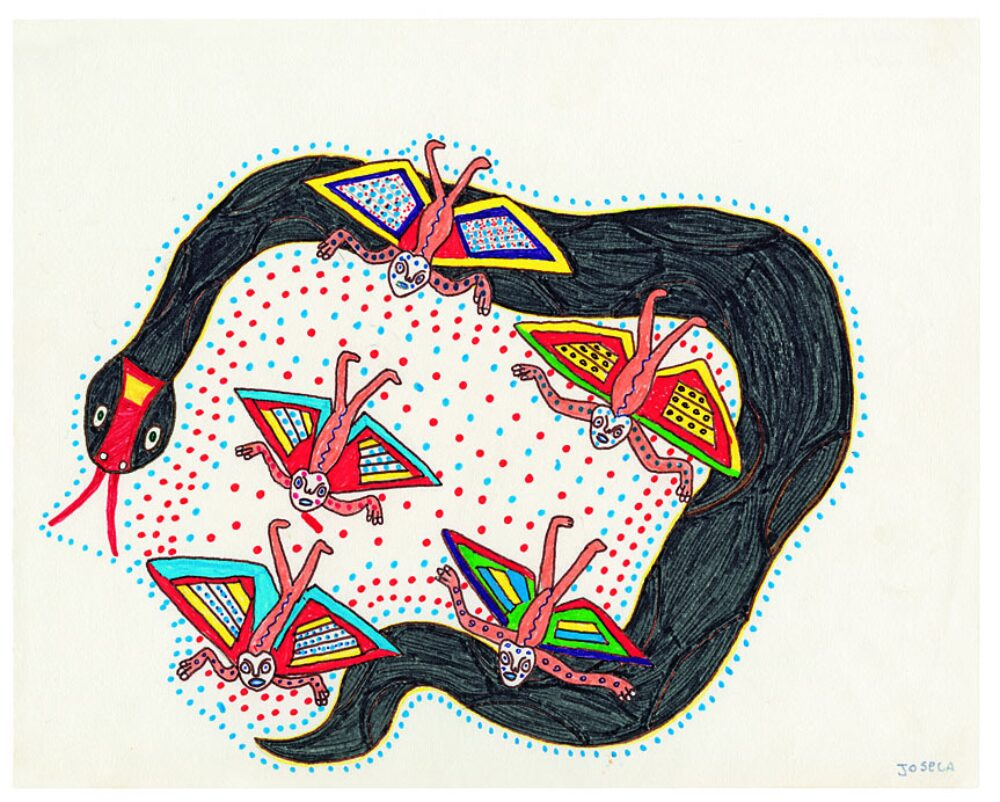
© Joseca Mokahesi
.
© Joseca Mokahesi
.
© Joseca Mokahesi
.
© Joseca Mokahesi
.
© Joseca Mokahesi
.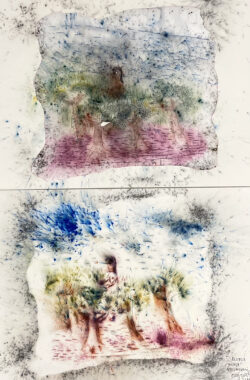
New York, incontro tra Cai Guo-Qiang e Ehuana Yaira
Ehuana Yaira e Cai Guo-Qiang si sono incontrati nel gennaio 2023 a New York, durante l'inaugurazione della mostra La Lotta Yanomami presso The Shed - una mostra a cui Ehuana Yaira ha partecipato.
Ehuana Yaira è un'artista indigena che è cresciuta e vive nella foresta, dipinge e disegna la vita delle donne yanomami, i personaggi femminili dello sciamanesimo e della mitologia yanomami, e i suoi stessi sogni.
Cai Guo-Qiang, artista cinese vivente à New York, fin dagli anni Ottanta ha esplorato le proprietà della polvere da sparo in spettacoli pirotecnici, ma anche come tecnica artistica specifica.
In occasione di questo primo incontro, i due artisti si sono avvicinati grazie a un'immediata empatia e Cai Guo Qiang ha invitato Ehuana Yaira a visitare il suo studio.
Durante questa visita, Ehuana Yaira è stata particolarmente colpita da una delle sue opere, Red Birds (2022), un dipinto ispirato da un sogno in cui l’artista ha visto sua nonna. Un sogno fatto quella notte stessa da Ehuana Yaira è diventato spunto per un’opera a quattro mani: una donna camminava da sola in un bosco coperto di fiori che le scendevano fino alla vita. Ehuana ha disegnato da sola inizialmente e lo studio ha, in seguito, trasformato il suo disegno in uno stencil. Cai Guo-Qiang ha cosparso lo stencil di polvere da sparo colorata che, una volta acceso lo stoppino inserito tra i due fogli, ha creato un’esplosione. Il fuoco ha dato nuova vita alla donna della foresta, sognata e disegnata da Ehuana Yaira. Questo incontro tra artisti intorno a immagini oniriche è prova degli scambi estetici e metafisici possibili tra culture solo apparentemente distanti.
New York, an encounter between Cai Guo-Qiang and Ehuana Yaira
Ehuana Yaira and Cai Guo-Qiang first encountered one another at the end of January 2023 in New York, during the opening of The Yanomami Struggle at The Shed, an exhibition in which Yanomami artist Ehuana Yaira participated.
An Indigenous artist who grew up in the forest and still lives there today, Ehuana Yaira paints and draws the lives of Yanomami women, female characters from shamanism and Yanomami mythology. Her dreams, too, figure in her paintings.
Cai Guo-Qiang, a Chinese artist living in New York, has been exploring the properties of gunpowder in his outdoor explosion events and performances, as well as developing techniques using gunpowder to create paintings since the early 1980s.
When they met in New York, the two artists came together through an immediate fellow-feeling which led Cai Guo-Qiang to invite Ehuana Yaira to visit his studio.
During her visit to the studio, Ehuana Yaira was particularly attracted to one of his works, Red Birds (2022), a painting inspired by a dream in which the artist saw his grandmother.
A dream Ehuana Yaira had that very night became the starting point for a collaborative work with Cai Guo-Qiang: a woman was walking alone in a forest covered with flowers that reached up to her waist. Ehuana made the drawing alone before it was turned into a unique stencil by the studio’s team. Cai Guo-Qiang spread coloured gunpowder over the stencil which, once ignited, caused an explosion - the fire giving life to the dreamy woman from the forest drawn by Ehuana Yaira. This encounter between artists, each finding inspiration in dreams, is a symbol of the aesthetic and metaphysical exchanges between worlds that, in the waking world, may seem so far apart.

Cai Guo-Qiang
Il lavoro di Cai Guo-Qiang è influenzato dai miti ancestrali e dalle tradizioni estetiche della cultura cinese, nonché dalla cultura occidentale contemporanea. Cai Guo-Qiang ha studiato scenografia a Shanghai dal 1981 al 1985, prima di lasciare la sua patria nel 1986 per continuare la sua formazione in Giappone. Si definisce un autentico "cittadino del mondo", il che spiega la preoccupazione di superare le barriere culturali che caratterizza il suo lavoro. Nel 1989, Cai Guo-Qiang ha attirato l'attenzione del pubblico con una serie di disegni intitolati "Progetti per extraterrestri", realizzati facendo esplodere polvere da sparo su carta giapponese. Dopo il 1989, Cai Guo-Qiang ha iniziato a realizzare produzioni ambiziose e complesse utilizzando materiale pirotecnico per creare esplosioni all'aperto, su grande scala. Nel 1995 si è trasferito a New York, dove vive tuttora.
Cai Guo-Qiang's work draws inspiration from ancestral myths and aesthetic traditions of Chinese culture as well as contemporary Western culture. Cai Guo-Qiang studied stage design in Shanghai from 1981 to 1985, before leaving his native land in 1986 to continue his training in Japan. He defines himself as an authentic "citizen of the world", which explains the concern to overcome cultural barriers so characteristic of his work. In 1989, Cai Guo-Qiang attracted public attention by making a series of drawings entitled Projects for Extraterrestrials which he created by igniting gunpowder on Japanese paper. After 1989, Cai Guo-Qiang began making ambitious and complex productions using pyrotechnics to create large-scale outdoor explosions. In 1995, he moved to New York, where he lives today.
Nato nel 1957 a Quanzhou, in Cina. Vive a New York.
Nel 1996, un evento afferma la sua carriera internazionale: l’opera intitolata Cry Dragon/Cry Wolf: The Ark of Genghis Khan è finalista alla prima edizione dell’Hugo Boss Prize del Museo Solomon R. Guggenheim, che premia l’innovazione nelle arti visive. Nel 1999, Cai Guo-Qiang ha rappresentato la Cina alla XLVIII Biennale di Venezia, dove ha vinto il Leone d’oro per la sua installazione Corte per la riscossione della mezzadria. Nello 2008, Cai Guo-Qiang ha tenuto una mostra personale al Guggenheim Museum di New York intitolata I want to believe. Per i Giochi Olimpici di Pechino del 2008 e per le Olimpiadi invernali di Pechino del 2022, l’artista ha diretto gli effetti speciali e pirotecnici delle cerimonie di apertura e chiusura dell’evento.
Artista di fama internazionale, Cai Guo-Qiang ha esposto in tutto il mondo. Il suo lavoro attinge a una varietà di simboli, tradizioni e filosofie orientali, nonché a questioni sociali contemporanee, trascendendo così i confini tra le culture. Le sue opere spesso alludono alla cultura o alla storia del luogo in cui vengono presentate, stabilendo un dialogo tra gli spettatori e il mondo che li circonda.
Lo stretto rapporto di Cai Guo-Qiang con la Fondation Cartier risale alla sua residenza d’artista nel 1993 à Jouy-en-Josas. La sua grande mostra personale del 2000 e la partecipazione a diverse mostre collettive hanno alimentato questo rapporto a lungo termine.
Born in 1957 in Quanzhou, China. Lives in New York.
In 1996, an event launched Cai Guo-Qiang's international career: the work entitled Cry Dragon/Cry Wolf: The Ark of Genghis Khan was a finalist for the first edition of the Hugo Boss Award at the Solomon R. Guggenheim Museum, which rewards innovation in the visual arts. In 1999, Cai Guo-Qiang represented China at the XLVIII edition of the Venice Biennale where he won the Golden Lion for the installation Venice’s Rent Collection Courtyard. In 2008, Cai Guo-Qiang had a solo exhibition at the Guggenheim Museum in New York titled I Want to Believe. The same year, Cai Guo-Qiang served as a member of the core creative team and as the director of visual and special effects for the opening and closing ceremonies of the Beijing Olympic Games, and of the Beijing Winter Olympics in 2022.
An internationally renowned artist, Cai Guo-Qiang has exhibited all over the world. His work draws from Eastern philosophy, traditions and narratives, as well as contemporary social issues, transcending cultural boundaries. His works often allude to the culture or history of the place where they are presented, establishing a dialogue between viewers and the larger universe around them.
The close relationship between Cai and the Fondation Cartier pour l'art contemporain dates back to his artist residency in 1993. His major solo exhibition in 2000, as well as his participation in several group exhibitions have nurtured this long-term relationship.

Ehuana Yaira
Ehuana Yaira è un’artista, insegnante, ricercatrice e leader femminile della comunità Watorikɨ. È la prima donna yanomami a diventare insegnante nella regione e a scrivere un libro nella sua lingua madre. La sua ricerca sulla trasformazione dei rituali intorno alla prima mestruazione di giovani donne è stata pubblicata con il titolo Yipimuwi thëã oni (Parole scritte sul menarca, 2017). Pioniera della sua generazione, Ehuana Yaira è una delle poche donne yanomami ad avere una carriera artistica. I suoi disegni, di solito densamente colorati, descrivono le attività quotidiane delle donne all'interno e all'esterno dello yano (casa comune) e personaggi femminili dello sciamanesimo e della mitologia yanomami. Le sue grandi figure e la quasi assenza di uomini nelle sue opere riflettono la centralità dell'universo femminile nella sua visione.
Ehuana Yaira is an artist, teacher, researcher and women's leader from the Watorikɨ community. She is the first Yanomami woman to become a teacher in the region and to write a book in her mother tongue. Her research on the transformation of rituals around girls' first periods has been published under the title Yi pimuwi thëã oni (Written Words on Menarche, 2017). Ehuana Yaira is one of the few Yanomami women to pursue an artistic career, a pioneer of her generation. Her drawings are generally densely coloured and depict women's daily activities inside and outside the yano (shared home), as well as female shamanic characters and figures of the Yanomami mythology. The scale of her characters and the virtual absence of men in her work testify to the central place that the feminine universe occupies in her vision.
Nata nel 1984 a Watorikɨ [Demini], stato di Amazonas, Brasile. Vive a Watorikɨ [Demini], stato di Amazonas, Brasile
Born in 1984, Watorikɨ [Demini], state of Amazonas, Brazil. Lives in Watorikɨ [Demini], state of Amazonas, Brazil
Ehuana Yaira ha illustrato libri didattici sulla medicina tradizionale (2015) e sulle lingue yanomami (2019). Nel 2018 ha coordinato l’11° raduno annuale delle donne yanomami. Ha inoltre recitato il ruolo di protagonista del film A Film for Ehuana (lett. “Un film per Ehuana”, Louise Botkay, 2018) e ha interpretato una parte in The Last Forest (Luiz Bolognesi, 2021).
Il suo lavoro è stato esposto per la prima volta nel 2019 dalla Fondation Cartier nella mostra Nous les arbres. Ha inoltre partecipato alla mostra Trees, presentata al Power Station of Art a Shanghai nel 2021, alla mostra Les Vivants a Lille nel 2022, e nel 2023 a La lotta yanomami allo Shed di New York.
Ehuana Yaira has illustrated didactic books on traditional medicine (2015) and Yanomami languages (2019). In 2018, she coordinated the 11th Annual Yanomami Women Gathering. She was the protagonist of A Film for Ehuana (Louise Botkay, 2018) and the interpreter of the feature film The Last Forest (Luiz Bolognesi, 2021).
Her works were exhibited for the first time by the Fondation Cartier in Paris in 2019 in the exhibition Nous les arbres. She also took part in the exhibitions Trees at the Power Station of Art in Shanghai in 2021, Les Vivants in Lille in 2022 and The Yanomami Struggle in New York at the Shed in 2023.
Image gallery

© Ehuana Yaira
.
© Ehuana Yaira
.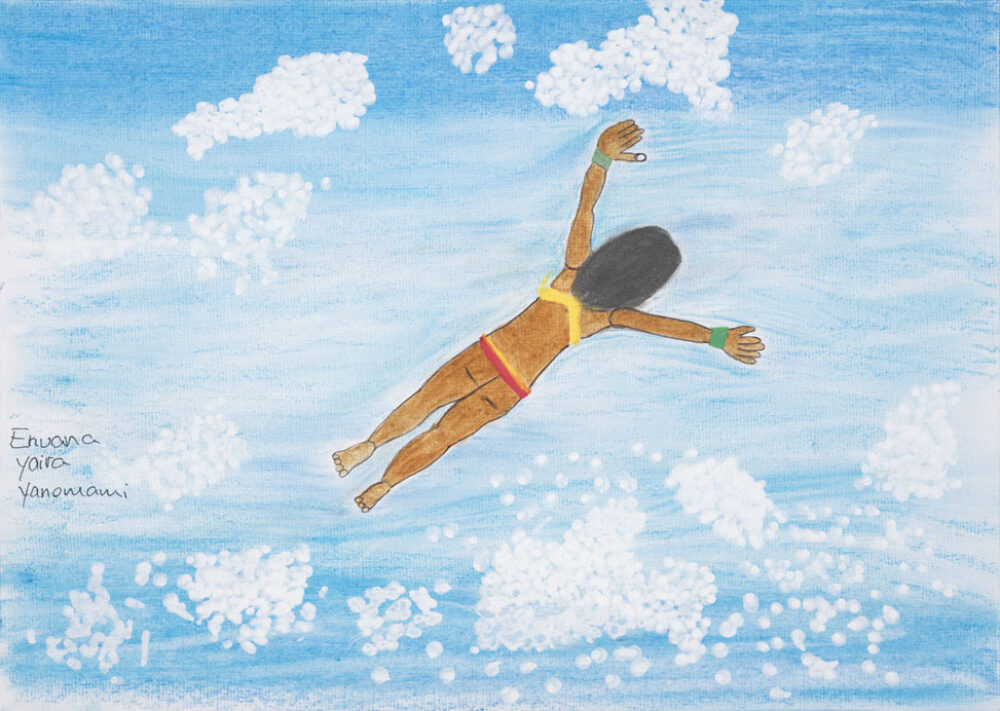
© Ehuana Yaira
.
© Ehuana Yaira
.Newsletter and social media.
To stay up-to-date with our news, follow us on